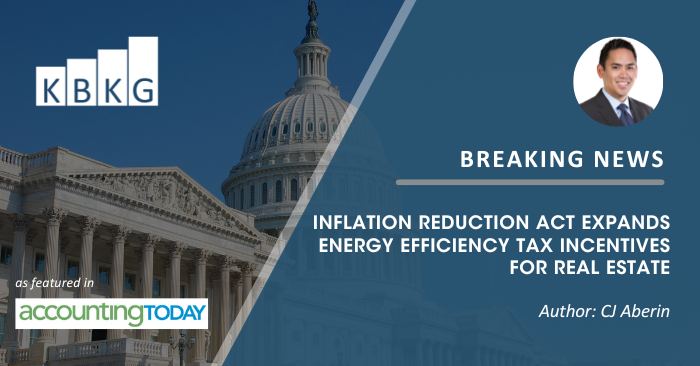As featured in Accounting Today
On Tuesday, August 16, 2022, President Biden signed the Inflation Reduction Act. Both existing and expired energy efficiency tax incentives including 179D Deductions and 45L Credits have been expanded significantly.
Who Benefits?
- Commercial Building Owners
- Multifamily Building Owners
- Investors
- Developers
- Homebuilders
- Architects
- Engineers
- Design/Build Contractors
- Other designers and builders
Increase and Expansion of 179D Tax Deduction
The already permanent 179D tax deduction has been significantly increased from the current maximum of $1.88 per square foot in 2022 to $5 per square foot to reward the construction of energy efficient commercial buildings and multifamily buildings that are 4 stories or taller. In addition to energy efficient ground up construction, energy efficient retrofits of older buildings will also be eligible. Furthermore, REITs will now have the ability to utilize 179D tax deductions for purposes of computing earnings and profits.
Additionally, tax-exempt building owners (such as non-profits) will gain the ability to allocate 179D tax deductions to architects, engineers, and designers responsible for designing a building’s energy efficient systems. Previously, only government building owners could allocate these tax deductions to their designers.
Extension, Increase, and Expansion of 45L Tax Credit
Originally having expired at the end of 2021, 45L tax credits have been retroactively extended for 2022 through the end of 2032, creating significant benefits for multifamily developers and homebuilders.
For 2022, both the existing energy efficiency criteria and the $2,000 tax credit per dwelling unit will remain unchanged.
Starting in 2023, the maximum tax credit increases to $5,000 per dwelling unit for both single-family and multifamily developments. Additionally, the energy efficiency criteria change to align with Department of Energy programs for Energy Star and Zero Energy Ready Homes. As a result, all residential developments become eligible whereas prior, only low-rise residential developments were eligible.
Key Observations
In some cases, maximizing the energy efficiency tax incentives within this legislation will require that construction wages for the project be paid at or above local prevailing rates as determined by the Secretary of Labor.
Additionally, with 45L tax credits changing to become applicable to all multifamily developments regardless of height, multifamily projects that are 4 stories or taller will be eligible for both 179D tax deductions and 45L tax credits.
With this legislation, Congress has made it clear that they intend to combat climate change by significantly expanding energy efficiency tax incentives across the board and making more parties eligible to partake in these incentives than ever before.
Questions about how the Inflation Reduction Act will positively impact your business and how to claim these tax incentives? We can help. Now is the perfect time to begin tax planning for 2023, and perform a lookback review of any retroactive claims that may exist. Contact us today for a no-obligation assessment.
About the Author

CJ Aberin, CCSP – Principal
Pasadena
CJ Aberin is a Principal at KBKG and oversees its Green Building Tax Incentives practice and helps manage its Cost Segregation practice. He has over 2 decades of experience in helping real estate clients maximize their tax benefits and currently serves on the Tax Policy Advisory Committee and the Sustainability Policy Advisory Committee of The Real Estate Roundtable. » Full Bio


